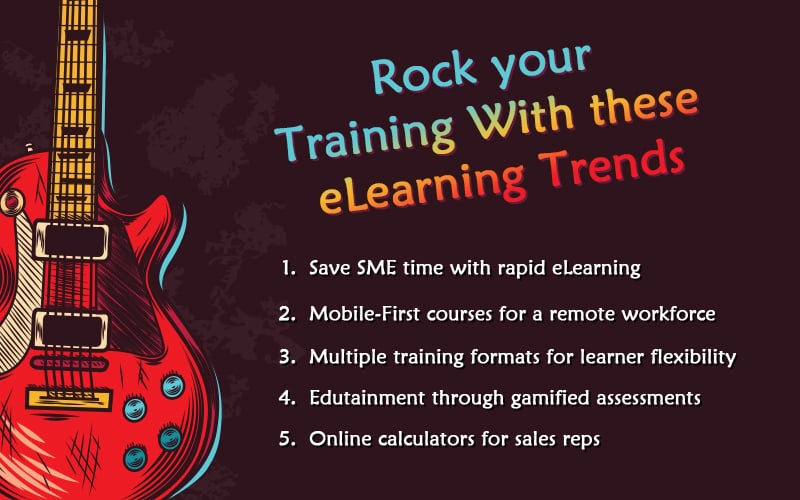Rock Your Training with These eLearning Trends

2020 is just around the corner! While some are busy enjoying the holiday season, others have already started thinking about preparing for training for the upcoming year. But where to start? What will your learners need to be trained on in the coming year? Is there anything new out there in eLearning that you could use to tantalize learners?
Latest eLearning Trends for Training Managers
- Save SME time with rapid eLearning
- Mobile-First courses for a remote workforce
- Multiple training formats for learner flexibility
- Edutainment through gamified assessments
- Online calculators for sales reps

With the start of a new decade, new eLearning opportunities await your learners, and as you step into 2020, an entire range of training options is open for you.
So that you don’t have to hunt around for them, we have compiled a list of 5 eLearning trends based on extensive industry research, in-depth analysis of the eLearning market, and our experience in providing eLearning solutions.
So, what are you waiting for? Go find the trends that will make a splash in corporate training in 2020.
5 Must-Know eLearning Trends
1. Save SME Time with Rapid eLearning
Though the primary job of a Subject Matter Expert (SME) is NOT training, they play a crucial role in the eLearning development process because of their sound content knowledge.
Considering that SMEs are extremely busy, it is very difficult for them to take out time for eLearning. Most organizations are struggling with the challenge of involving them in training without impacting their busy schedules.
So how do we ensure optimal utilization of the SME’s time for eLearning? Is that really possible?
Yes, it’s possible. Many organizations have found a way of getting 80% results by using only 20% of their SME’s time.
→ Download this e-booklet thar offers 10 practical tips to save SME time.
How was this done? By involving the SME at a maximum of 3 touchpoints in the entire development process.
Touchpoint 1: The SME hands over a rough PPT along with his voice recording to give the development team a quick overview of the PPT and highlight its important points.
The eLearning development team converts the PPT into an instructionally sound eLearning course and sends the course along with the audio script to the SME.
Touchpoint 2: The SME reviews (and provides feedback on) the course and script.
The development team implements SME feedback on the course and script, adds professional narration, and submits the final course.
Touchpoint 3: The SME reviews the course and signs-off on it.
2. Mobile-First Courses for a Remote Workforce
Those days are long gone when learners used to access training only on their desktops. Millennials, who make up over one-third of the US workforce, like to learn on-the-go and prefer having access to learning on digital devices such as smartphones and tablets.
In response to these modern mobile learning needs, many organizations are prioritizing design for mobile. In fact, in 2019, around 70% of global companies offered mobile learning in some form (Source: Docebo).
This strategy is essentially to design for the smallest screen first (mobile devices) and then moving on to a larger screen (desktops or laptops).
By leveraging responsive design and a mobile-first learning strategy, employees who are remotely placed are also able to access courses, both online and offline.
Adopt this trend and create courses that are accessible across devices such as Android smartphones and tablets, iPhones, iPads, laptops, and MacBooks.
3. Multiple Training Formats for Learner Flexibility
When you have a diverse set of learners with an eclectic mix of learning styles and preferences, a ‘one-size-fits-all’ training solution doesn’t work. Some learners are auditory, some visual, while others are kinesthetic (learning-by-doing). The bottom line is that rolling out courses in a single format and forcing them on learners leads to poor engagement and impacts job performance.
Realizing this, organizations are now preferring to develop the same content in different formats. For example, videos for those who find visual training engaging, and audio files for learners who concentrate better with auditory elements. So you can get started with blended learning.
Learners can pick up a suitable format according to their learning preferences. Having the same course published in different formats gives learners the flexibility to learn the way they wish to. This, in turn, helps them concentrate and grasp information better.
4. Edutainment through Gamified Assessments
A growing number of companies are using edutainment – not only for training but also for assessments.
Edutainment combines education and entertainment— to present content in a less rigid and traditional way, It enables learners to enjoy the learning and have fun during the process.
Here’s how edutainment in implemented in eLearning assessments:
- Structuring content inside assessments in the form of a narrative/story
- Gamifying the assessment on the lines of popular reality game shows, awarding points and badges for every correct response
- Providing learners a certain number of tries or ‘lives’ to complete the assessment
Gamifying will enliven assessments and reduce monotony when learners are tested in on knowledge retention at spaced intervals.
5. Online Calculators for Sales Reps
Online sales calculators (a.k.a. online ROI calculators) are being used by organizations to equip their sales reps with accurate information on diverse products to help them build a strong case for their product against competition. These sales calculators help sales representatives convince clients (B2B consumers) on the advantages offered by their products.
Using a sales calculator, a sales rep can determine the exact amount their client can save in terms of money and time, and the returns they can expect in the future.
It is well-known that sales reps find it difficult to ask prospects the right questions. Providing them with tools like online calculators eases their work to a great extent and helps them accelerate their performance.
Let’s Call it a Wrap
As the workspace is evolving, it pays to keep abreast of the latest eLearning trends to ensure your employees remain engaged and grow in performance. Impact your organization in 2020 with these effective training trends.
The list doesn’t end here…there are many more. To explore them all, download our free ebook – eLearning Trends for 2020: 21 Cool Ideas You Can Try! It’s a treasure trove of the latest eLearning trends…that have been tried, tested and evolved into successful training programs adopted by Fortune 1000 companies.





